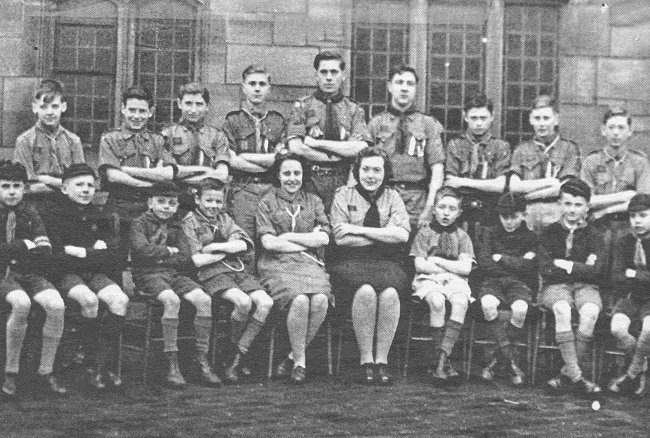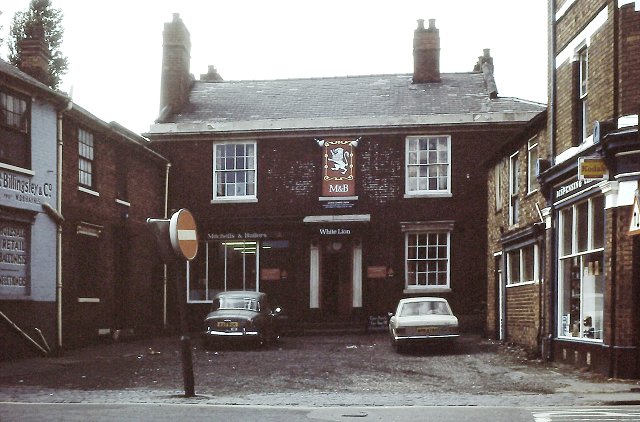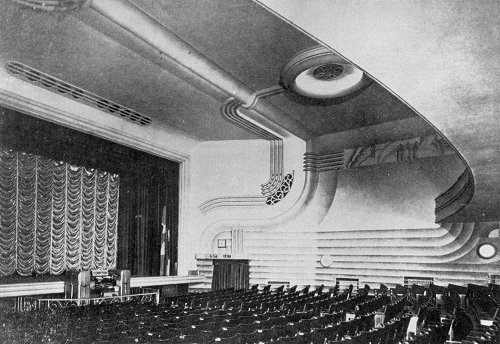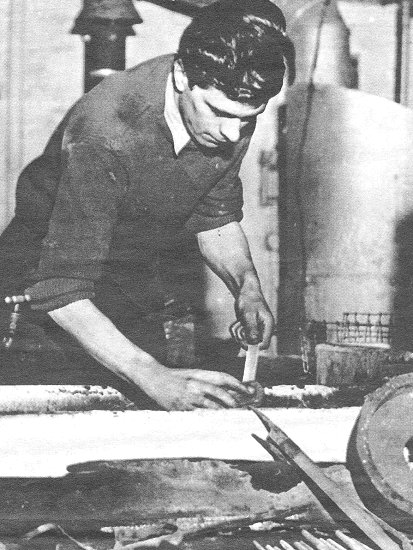|
Brian F. Amos J.P. now lives in Paignton,
Devon, but his roots in the Black Country strike deep and his
memories of his younger days remain strong. He has written to me
with a thoughtful account that gently stimulates memories of the
past.
"I was born in 1930 in Willenhall Street,
on the local council estate in Darlaston. There are many happy
memories of living there and other parts of "Darlo" in
subsequent years. All the residents were friendly. No locked
doors, children playing in the street without fear and dread,
and each helping any others in need.
At the age of five I became a member of the
Darlaston gang who plagued the Willenhall gang if they ventured
onto our territory over the canal. Plagued and ran away. During
the summer months we used to swim in the canal without our
parents' knowledge. We moved to Cramp Hill opposite St. Lawrence
Church, a terraced house with the front door onto the road. The
house was next door to my Grandad and Gran Foster, who between
them ran the coal yard and removal business. |
|

A view of Willenhall Street from
Great Croft House in 1965. |
|
Brewhouse
The large yard behind us housed the
cart, removal van, stable for the horse, Dolly, outside
toilet and brewhouse (brewus) facilities. Gran shovelled
and weighed the coal, Grandad did his removals. Monday
was always wash day with the boiler full to capacity and
then "maiding" the washed clothes. Fireplaces were open
grates, meat hanging from chains to cook with the fat
running onto a pan on the hearth.
I started my education at St.
Lawrence Church of England School, just around the
corner with the headmaster Mr. Nicholls, and teachers
Miss Beddall and Miss Betty Lowe. We were marched in a
crocodile line a couple of times a year to visit the
health clinic behind Slater Street Boys School and down
the gulley - once for teeth examination and once for
nits.
I joined the church Wolf Cub group
run by a Miss Ball with meetings held in the church
hall. Later I joined the choir with Billy Whitehouse as
choir master and organist. Mr. Ben Delay was verger to
the church. The Rector, Dr. Lavelle, was assisted by his
curate the Rev. C. A. Harris, who later became
scoutmaster to the church group.
Cramp Hill was a series of small
terraced houses where lived Ben Delay, next door to two
sisters and their brother (all unmarried). They were
Little Emma (as we knew her), sister Sarah and brother
Tom. The Conservative Club bowling green was next door.
The Burns family had a gentlemen's hairdresser's shop
and opposite were the Babbs family whose father went to
war in 1939. The corner shop was run by a Mrs Webb and
was where we spent our weekly princely sum of 3 old
pence. The Labour Club just down the road stood opposite
the Civic Restaurant.
Saturdays were spent at the "penny
pictures" held in the Methodist Church Hall in Slater
Street. Films such as "The Clutching Hand" frightened us
all. The "Lymp" and the "Drome" were the alternative
cinema venues. The foyer at the "Lymp" was quite
spacious and people were met by the dapper manager, Mr
Mould. Inside, after the news, the usherettes would
spray a scented air freshener called "June" which was
quite pleasant when landing on you. Mr. Mould lived in
King Edward Street, near to a friend of mine. With
ration coupons issued for almost everything, he had an
allocation of sweets (which were hard to come by in
those days). When he attempted to place these on
display, he was besieged by the customers, so he took
them home with him. The cinema was always warm, this was
perhaps due to the dormant coal seam lying underneath
which needed attention every so often. |
|

Old Church School. |
|
Railings
Cub meeting were held on Tuesdays,
with Scouts on Thursdays. Wednesdays were for choir
practise and since the church hall was just some 20
yards from our front door, it wasn't very far to go. For
attending weddings we were paid three old pence,
funerals one penny. The war years saw a few changes such
as the railings removed from around the church, and the
placing of an Anderson bomb shelter in our next door
neighbour's yard (Mrs Titley) where we all adjourned
when the siren sounded. It was a damp and dark
experience. Grandad refused to get out of bed to join
us.
Progressing from the Cubs to the
Scouts gave a more expansive help in life. Weekend
camping at Gay Hills in Claverley, taking part in the
International Camp at Beaudesert, Cannock, attending
Windsor Castle for Kings Scouts, and the International
Jubilee Camp at Moisson near Paris. The 3rd Darlaston
Scout troop were accompanied at Beaudesert by its twin
group the 5th Paris troop which, unknown to us, included
six "chieftens" (cub mistresses) and we were placed away
from the main camp.
At the close, the Parisian Scouts
were accommodated in our homes in Darlaston. We had
Michelle Bousch, sister of the leader. She was rather
thin but wore heavy boots. Nicknamed "The Bug with clogs
on", she followed us everywhere. She would be aged about
20 while we were 14 and 15 years. We later discovered
that her parents had two chateaux and a sumptuous town
house in Paris. Our efforts for the war were to collect
waste paper which we weekly stored in an empty property
just off the High Street, down the gulley into
Blakemores Lane. At the end of the war it was bulging
with waste which no one seemed to remove even when the
war ended.
Each year there were anniversaries.
St. Lawrence's Church, the Methodist and Catholic
Churches, all joined together to parade around the town.
Most residents came out to see us led by the Salvation
Army Band, the Police, Fire Brigade, the choirs and
Sunday school members. There would be up to 100
attending. The same applied to Armistice Day when we
gathered round the Cenotaph in the park by Rectory
Avenue. The bandstand in the adjacent park was regularly
used on Sundays with people sitting round enjoying the
sunshine and music.
My father joined the Darlaston
(Staffordshire Force) Police before the war. Inspector
Plumley was superintendent at the station in Crescent
Road. It was a rather imposing building. Police were out
walking the streets in full view of all - never much
trouble those days.
The Town Hall was used for various
functions such as the annual Police Ball, the (Council)
Chairman's Ball, weekly dances and more importantly
possibly, the annual week for the Darlaston St. Lawrence
Operatic Society performances. |
|

The Scouts and Cubs at St.
Lawrence's Church. Brian Amos is standing in the middle
of the back row. |
|
Rehearsals
These productions were generated by
stalwarts such as Edith Walford, Reg Nicholls (Musical
Director), leading actors such as Billy Ford, Sam
Cooper, Betty Baker, Sabra Wilkes and many more who
attended the rehearsals in the Church Hall in Pinfold
Street twice weekly. The Town Hall would be full every
night. Characters such as Bob Smith and Billy Muggins
were well known in our community. Bob for his toys and
Billy for his cart. He would go round the various pubs
doing his various sayings (like the Lord's Prayer
backwards) and pass his hat round. Many times he was
heard to say "and they think I'm saft!"
The Salvation Army band played
outside their premises each Sunday. At this time our
family had moved from Cramp Hill to just around the
corner in New Street, living in the flat above the
Lloyds Bank premises. Arriving home from school we would
need (sometimes) to help clean the bank premises, coming
across packets of ten shilling notes (£100) lying under
the desks, and occasionally finding the door to the safe
left unlocked. This took a telephone call to
Wolverhampton to recall the bank manager who appeared
none too happy.
Groups of us would cycle to Villa
Park to get tickets for the various internationals and
cup matches held there. This would be six or seven miles
from Darlaston. Leaving our bikes on the verges we would
queue for some hours, getting the tickets and then
coming back to where the bikes were left. No damage, no
theft. Just picked them up and cycled back. An alleyway
at the rear of the premises led to the White Lion pub
kept by Mr. and Mrs Nicholls. Their son (Harmar) later
became Chairman of the Council and was knighted. His
daughter, Sue Nicholls, became a leading character in
Coronation Street.
The back room of the White Lion was
used by the Darlaston FC committee to make their
deliberations as to the content of the team for the
following Saturday. The bowling green at the rear wasn't
used all that much those days. This pub became my
watering hole (plus the Swan Pub opposite) for many,
many years after, including my stag night. Excellent
company. |
|

The White Lion in King Street.
Taken by Richard Ashmore. Courtesy of John and Christine
Ashmore. |
|
In later years, the 50s and 60s
would see a fairly successful Darlaston Football Club
playing in the Birmingham Combination. Ken Bayley (ex
Wrexham FC) was in goal and I was at centre half. At
this time the Darlaston Ladies FC was formed and they
played local ladies' teams, Dudley, Bilston, etc. I
remember Brenda Bytheway playing in goal and being
winded while playing Dudley ladies. Some of our team
were acting as trainer to the team and four of them ran
with a sponge to help her.
I also recall Ken Bayley playing in
goal against Cradley Heath away. We were winning one nil
till they were awarded a penalty, which he saved in the
last minute. Walking back to the dressing room we were
subjected to some abuse, particularly Ken. In stepped
Kath (his wife) who promptly set about them with her
umbrella. All good fun!
While playing for the town, a
successful response by the electorate in All Saints Ward
saw me sitting with five other Conservative members of
Darlaston Council, made up with fourteen Labour members.
Sir A. G. B. Owen, Tom Croft and Mrs Purcell were three
of the Conservatives and Mrs Ellen Wilkinson and her
husband, Frank Baker, among the Labour team. Ellen,
Frank and A. G. B. Owen all were past chairmen of the
council. Some with Ellen and Frank were shop stewards of
one or other of the many firms in Darlaston and others
were members of the Labour Club.
This was at a time when Darlaston
was a thriving community with hundreds of people
thronging from the trolley buses and buses arriving at
the Bull Stake, walking down towards the Green where the
main factories were housed. All Councillors gave their
time and efforts without pay or expenses. Meetings were
held in the evenings in the Council Chamber so that our
working day was never interfered with. Mr. Rowlands, the
Town Clerk took notes. Certain members were chairmen of
various committees, such as the allotments, the library,
housing etc. All Councillors, regardless of politics,
worked hard and well together for the good of all the
community we served.
Apart from Alfred Owen, all members
were born and bred in Darlaston. Alfred, being one of
the main employers in the town, had a very great
affection and more than shared equally towards the well
being of the town.
Exciting
A couple or so reminiscences of
those six years. The Regal Cinema had been built and
Leslie Taff played the organ and was later owner. The
film Rock Around The Clock was renowned for exciting the
audiences but a local cinema in West Bromwich had shown
it without any undue problems. |
|

The Regal in the late 1930s.
|
Leslie Taff made a request to the Council to screen
it. We were all invited to a special showing on a Sunday
afternoon with tea and coffee and cakes and other
beverages a big stronger. We all agreed it was nothing
out of the ordinary, and that it could be shown.
The first night it was screened, the audience went
mad with excitement and caused a few problems. Mr. Taff
immediately withdrew the film. |
|
Chairman Frank Baker was invited by
the builders to officially open the 1,000th house on the
Bentley Estate. We were all invited with husbands and
wives in attendance. Chairs were made available on the
front lawn and we all sat and heard the chairman's
speech, which unfortunately went on a little too long
and it started snowing. We all sat there with little
piles of snow on our heads before we were invited
inside.
An important document was received
by Mr. Rowlands from London - the Local Government
Re-organisation proposal. Local councils (Bilston,
Wednesbury, Willenhall etc.) were invited to discuss the
future of each town or amalgamation with the various
surrounding County Boroughs. Many meetings were held
with other
councils and eventually we were all
of the opinion that a new county borough should be
formed incorporating us all with a name to be agreed
later. The Town Clerk, the Chairman, Frank Baker, Tom
Croft and I travelled down to London to put the
Darlaston Council views and decisions to the appropriate
committee dealing with local government. They listened
politely to our presentation, at the end of which they
declared that the three members had resided in our local
community for the past two months and had agreed between
themselves that the appropriate action should (and
would) be for each urban district council to be absorbed
into the nearest County Borough - Darlaston into
Walsall, Wednesbury into West Bromwich, Willenhall into
Wolverhampton and so on. That then, I feel, is the
reason that Darlaston no longer exists as an entity and
the web site "Ugly Walsall, my home town" says it all.
William Amos and Son
(File and Rasp Manufacturers) St. George's Street,
Darlaston.
The firm started as Amos and
Hampton, a partnership between my grandfather, William
Amos and Reuben Hampton on July 21st, 1916, in a single
storey building in St. George's Street, next door to St.
George's Church Hall. This association was dissolved on
October 12th, 1936, and Grandfather Amos continued in
the business with my father, William Randolph, of the
hand and machine cutting of engineers' files.
Rubery Owen and Co. Ltd. together
with GKN Wiley, Nuts and Bolts Ltd. and many others in
and around Darlaston, were good customers of the firm.
Precision files were also hand cut by my father for the
lock trade in Willenhall. |
|
The business expanded and the start
of the Second World War saw a surge in trade. The
government made approaches to William Amos to relocate
but he refused, deciding to stay where he was.
New machinery was installed to
cater for the increase, being driven by belts from one
of two large motors. At most there were some ten
employees, among whom would be two uncles and aunts,
plus for some three or four years, my mother.
Used and worn files would be
collected from the various factory stores, sorted into
shapes and sizes, and placed in rows with coal between,
to a height of three feet. This was done in a specially
built fire place. The front would be bricked up and the
fire lit.
After two days when cool, the files
would be softened (annealed) and ready for grinding. New
teeth were then machined into the files, followed by
hardening in the sodium cyanide furnace until red hot
and then plunged into cold salted water. The files would
then be brushed individually with slurry oil, placed by
the stove to dry and then packed into bundles of six or
twelve depending on the size and shape. |

Brian Amos at work. The files had
been hardened by his dad and Brian was brushing out the
teeth to get rid of sodium cyanide. |
|
In 1950 my grandfather retired and
I joined the firm following my return home from National
Service, generally doing jobs that no one else wanted.
The firm was awarded an overseas contract from the
Nigerian Railway to recut some seven tons of files which
arrived in ten large drums and needed manhandling from
the lorry into the factory for sorting.
Expanded
Two houses on the main road had
been acquired and were used for the sorting and storage
of files. The two cellars below were utilised for
storing the old, used grindstones. It is noticeable that
the area where these were put has been grassed over.
There would perhaps be some hundred or so stones below.
Prior to 1960, a firm called Comley
and Pitt Ltd. of Pensnett expanded their business
(leasing factories on their trading estate) in the
chemical resharpening of files. This was a much cheaper
method with a much faster turnaround. Many of our
customers were lost and three other small manufacturing
family firms accepted offers to relocate to Pensnett.
The erosion of our trade finally forced my father to
accept an offer and he, together with three other
employees, were transferred. Some few years later, all
the machinery was scrapped and manufacturing stopped. My
father was the last survivor of hand cutting files." |
 |
Return to
the
previous page |
|